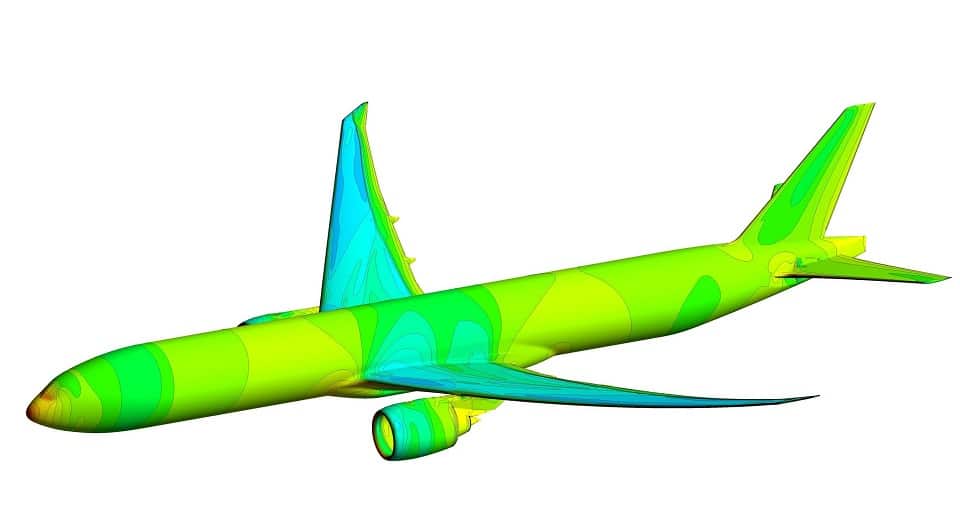Aerospace
Lufthansa Technik Uses Ansys to Develop and Certify AeroSHARK Technology

In order to design and certify AeroSHARK, a biomimetic coating technology that mimics shark skin and greatly lowers fuel consumption and carbon dioxide (CO2) emissions, Lufthansa Technik, one of the world’s top providers of technical aircraft services, integrated Ansys simulation systems.
Lufthansa Technik and BASF, a chemical business, created the coating film with a slight ribbed structure made up of tiny elevations known as riblets by utilizing Ansys’ computational fluid dynamics (CFD) and high-performance computing (HPC) technologies.
Lufthansa with aerodynamic sharkskin film(Opens in a new browser tab)
The placoid scales on a shark’s skin, which let them smoothly cut through water by lowering drag and friction while improving buoyancy, are mimicked by the riblet effect. To be sure the riblets’ surrounding turbulent flow phenomena would provide the same effect, engineers employed Ansys’ CFD software.
Before scaling and customizing the AeroSHARK prototypes through extensive aerodynamic simulations, Lufthansa Technik built and validated smaller, more generic virtual prototypes using Ansys’ capabilities. Lufthansa Technik significantly shortened the time it took to obtain certification by being able to simulate the entire aircraft, including in-flight behavior, and verify the Riblet effect using cutting-edge turbulence modeling.
Lufthansa Technik to maintain India’s Vistara Dreamliners in Frankfurt(Opens in a new browser tab)
Swiss International Air Lines (SWISS) and Lufthansa Cargo are now using AeroSHARK, which has been approved for use on two models of Boeing 777s by the European Aviation Safety Agency (EASA) and the American Federal Aviation Authority (FAA). After receiving their AeroSHARK modifications, all eleven Boeing 777Fs at Lufthansa Cargo and all twelve 777-300ERs at SWISS will cut the yearly carbon footprint of the Lufthansa Group by more than 25,000 tonnes.
As a result of successful simulation-powered testing, AeroSHARK is currently able to cover 40% of the aircraft, with plans to eventually expand its coverage to other parts of the aircraft.

Aerospace
When Ratan Tata was denied entry to the airfield at the Aero India show, he waited

During our visit to Aero India 2019, we had the unexpected opportunity to see Ratan Tata at the event, which was a thrilling moment for us. However, there was a surprising hiccup when the security staff didn’t allow him to enter due to a lack of a security pass.
Despite this, he remained calm and patiently waited for about 20 minutes until a member of the Tata team brought him the required pass, after which he calmly proceeded inside. It was a humbling sight, showcasing his composed demeanor even in such situations.
Ratan Tata ji is not only a renowned industrialist but also a trained pilot, holding a pilot’s license. In 2007, he became the first Indian civilian to fly the F-16 Falcon during the Aero India show in Bangalore—a proud moment for the nation.
His passion for aviation extended beyond flying, as he played a key role in shaping India’s aerospace industry. Under his leadership, Tata ventured into manufacturing and maintaining aerospace components while upholding its legacy of quality. Notably, Tata’s collaboration with Airbus to develop and manufacture the C295 aircraft is a testament to its growing influence in the sector.
-

 Aviation2 months ago
Aviation2 months agoMicrosoft Flight Simulator Raises $3 Million to Bring Back the An-225 Mriya
-

 Airlines2 months ago
Airlines2 months agoQatar Citizens Can Travel to the United States Without a Visa
-

 Aviation2 months ago
Aviation2 months agoQatar Airways bans these new Electronic Devices on plane
-

 Airlines2 months ago
Airlines2 months agoJapan Airlines Rolls Out Free Domestic Flights to International Passengers
-

 Defence2 months ago
Defence2 months agoWhich Country Has the Largest Fleet of Fighter Aircraft?
-

 Travel2 months ago
Travel2 months agoQatar Airways Launches Four Additional Flights from Amsterdam
-

 Airport2 months ago
Airport2 months agoWestern Sydney Airport Welcomes Its First Plane After 6 Years of construction
-

 Airlines4 days ago
Airlines4 days agoDAMAC Air: Dubai’s New Luxury Airline Offers Free Flights for Registration








